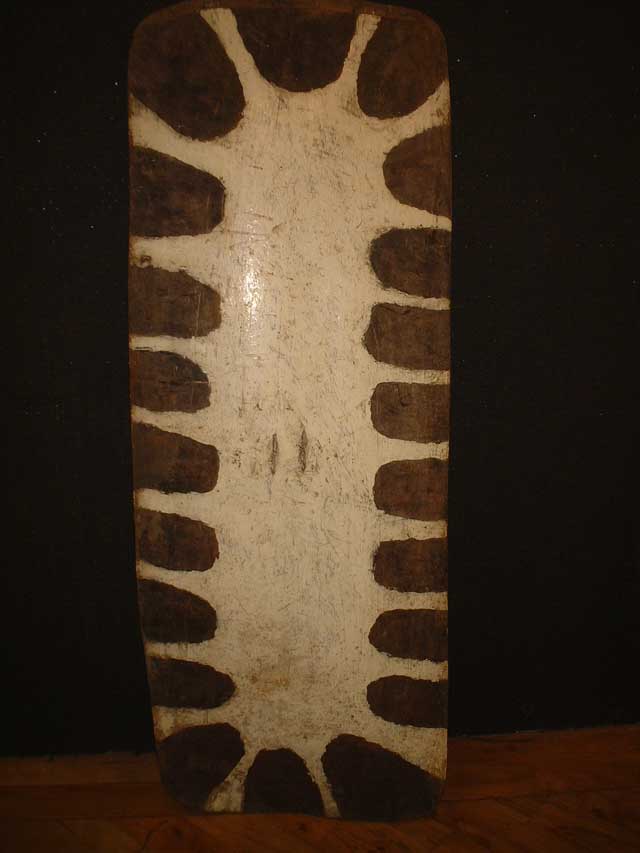|
|
|||||||||||||
 |
|||||||||||||
Modernity and the 'graphicalization' of meaning: New Guinea Highland shield design in historical perspective.
Introduction If the major concern in studies of the anthropology of art and of material culture over the last three decades has been with 'meaning' (Coote & Shelton 1992: 4), then the dominant models or metaphors in terms of which that meaning is to be disclosed have undoubtedly derived from language. Art, material culture (and, of course, much else beside) have endlessly been 'read', their constituent forms and designs compared to linguistic units of different orders, and analysed for their combinatorial rules to see what 'messages', thus 'decoded', they 'communicated' (see, for example, Barthes 1973; Sahlins 1976; Layton 1981).More recently, however, what had always existed as a muted countercurrent to the linguistic analogy has been foregrounded. Miller (1987: 95-6), for example, has argued that the imposition of linguistic models has had the effect of 'subordinating the object qualities of things to their word-like properties'. McCracken (1988: ch. 4) has disputed the appropriateness of a linguistic analogy even when applied to its heartland territory of dress, so often analysed as 'the language of clothing'. Earlier, Ong (1982) had delineated the 'chirographic' mindset which hides from us the extent to which literacy has pervaded our understanding and, as Gow (1990) has shown, can lead to misdirected efforts to find a semantic and representational key to indigenous design. Gell (1992: 43) has similarly alluded to the defects of an iconographic approach which 'treats art as a species of writing, and which fails ... to take into consideration the presented object, rather than the represented symbolic meanings'. More broadly, and beyond anthropology, Stafford (1993: 463) has traced what she regards as our inhibiting tendency to 'see images linguistically' back to the eighteenth century when, she argues, perceptual apprehension became established as 'an inferior gnosis' to non-visual, written modes of knowing.It would be a mistake, however, to polarize the issue and to reject linguistic analogies as fervently as they were initially embraced. As Morphy (1994: 665) remarks, 'many of the theoretical controversies in the analysis of art ... have resulted from a failure to recognize the multidimensional nature of objects and the immense variety of ways in which meanings can be represented'. Quite possibly, aesthetic systems may differ empirically in the degree to which they are language-like and thus in the extent to which linguistic models are helpful in understanding them (O'Hanlon 1989: 19). Before finally accepting or rejecting such a model, one would also want to be clear as to the specific aspect of language to which the object-world is being compared: whether it is the fact that language is structured, or that it is communicative, or that its rules have been internalized by native speakers whose knowledge of them is thus often held unconsciously, or the representationalism which underlies the distinction between signifier and signified.My purpose here, though, is less to reassess whether linguistic models were originally the best ones for analysing the object world than to examine a contemporary counterpart to that argument and, in doing so, to touch on the still neglected topic of aesthetic change. The point I want to make is a simple one. It is that if indeed we have been unduly concerned with the notion of 'reading' objects, with attributing word-like properties to design and motif and interrogating them for their meaning by virtue of those properties, then the same broad influences which made that seem the approach to take are also likely to be having an effect locally. In other words, whether or not such linguistic analogies were originally appropriate, subsequent changes - and here I have in mind the impact of literacy, the explosion of goods and advertising and other specific aspects of modernity(1) sketched below - may be making them so.One goal of this article is to examine this through a remarkable category of objects: the battle shields used by the Wahgi, a people of the Western Highlands Province in Papua New Guinea. What makes these shields especially interesting is their discontinuous and mutating history. Once a defining feature of Wahgi warfare, the shields effectively vanished as the Australians suppressed local fighting in the years following 'first contact' in the 1930s. Then, after three decades in latency, the shields were reinvented for the renewed warfare of the 1980s, but now with designs whose older communicative modality had been given a new graphical dimension engendered by the intervening encounter with modernity. Finally, changing military .. If you would like to see a full version of the paper please click here (external link).
|
Highland shields 1 |
||||||||||||
|
Disclaimer: i do not own any of the shields below.
|
|
||||||||||||
|
|
|||||||||||||
|
|
|||||||||||||
|
|
|||||||||||||
|
|
|||||||||||||
|
|
|||||||||||||
|
|
|||||||||||||
|
|
|
||||||||||||
|
Home| Photography| Oceanic Art | Links Contact me Copyright © Your Company Name designed by Templatesbox |
|
||||||||||||
|
|
|
|
|
|
|
|
|
|
|
|
|
|
|









